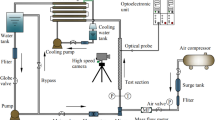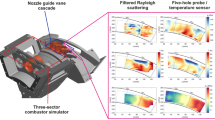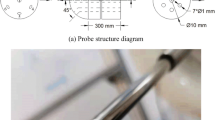Abstract
The development of a three-hole pressure probe with back-flushing combined with a conductivity probe, used for measuring simultaneously the magnitude and direction of the velocity vector in complex air–water flows, is described in this paper. The air–water flows envisaged in the current work are typically those occurring around the rotors of impulse hydraulic turbines (like the Pelton and Cross-Flow turbines), where the flow direction is not known prior to the data acquisition. The calibration of both the conductivity and three-hole pressure components of the combined probe in a rig built for the purpose, where the probe was placed in a position similar to that adopted for the flow measurements, will be reported. After concluding the calibration procedure, the probe was utilized in the outside region of a Cross-Flow turbine rotor. The experimental results obtained in the present study illustrate the satisfactory performance of the combined probe, and are encouraging toward its use for characterizing the velocity field of other complex air–water flows.





















Similar content being viewed by others
Abbreviations
- A ex :
-
Nozzle exit area (m2)
- C air :
-
Air concentration or void fraction
- C pr :
-
Air concentration indicated by conductivity probe
- H :
-
Head applied to turbine (m)
- K i :
-
Coefficient relative to the ith pressure taping
- \( \dot{m}_{\text{air}} \) :
-
Air mass flow rate (kg/s)
- p air :
-
Air gauge pressure (Pa)
- p dyn :
-
Jet dynamic pressure (Pa)
- p i :
-
Pressure at the ith pressure taping (Pa)
- p mix :
-
Mixture gauge pressure (Pa)
- p n :
-
Pressure at standard conditions (p n = 101,325 Pa)
- p s :
-
Static pressure (Pa)
- Q air :
-
Air volume flow rate (m3/s)
- Q n :
-
Air volume flow rate at standard conditions (T n = 273.15 K and p n = 101325 Pa) (m3/s)
- Q tot :
-
Total volume flow rate of mixture (m3/s)
- Q w :
-
Water volume flow rate (m3/s)
- r ex :
-
Nozzle exit radius (m)
- R :
-
Ideal gas constant [R = 287 J/(kg K)]
- t air :
-
Air temperature (°C)
- t mix :
-
Mixture temperature (°C)
- T n :
-
Temperature at standard conditions (T n = 273.15 K)
- U :
-
Rotor tip velocity (m/s)
- U/V0:
-
Blade-jet velocity ratio
- V :
-
Local velocity (m/s)
- V j :
-
Velocity of calibrating jet (m/s)
- V 0 :
-
Jet velocity given as: \( V_{0} = \sqrt {2gH} \left( {{{\text{m}} \mathord{\left/ {\vphantom {{\text{m}} {\text{s}}}} \right. \kern-\nulldelimiterspace} {\text{s}}}} \right) \)
- V/V0:
-
Non-dimensional absolute velocity (m/s)
- α :
-
Absolute velocity angle (degrees)
- β :
-
Relative velocity angle (degrees)
- γ :
-
Probe rotation angle (degrees)
- θ :
-
Rotor peripheral angle (degrees)
- ρ air :
-
Air density (kg/m3)
- ρ air,mix :
-
Air density in the air–water jet (kg/m3)
- ρ mix :
-
Mixture density (kg/m3)
- ρ w :
-
Water density (kg/m3)
- air:
-
Relative to the air part of the mixture
- dyn:
-
Dynamic
- ex:
-
Exit
- i :
-
General pressure taping
- j:
-
Jet
- mix:
-
Relative to the air–water mixture
- n:
-
Standard
- pr:
-
Probe
- s:
-
Static
- tot:
-
Total
- w:
-
Water
References
Amador A (2005) Comportamiento hidráulico de los aliaderos escalonados em presas de hormigón compactado. PhD dissertation, Universitat Politècnica de Catalunya (UPC), Barcelona (in Spanish)
Bachalo WD (1994) Experimental methods in multiphase flows. Int J Multiph Flow 20(Suppl):261–295
Bachmeier G (1988) Setup, calibration and use of a measuring probe for determination of air concentration in a spillway chute. Diploma dissertation, Institute for Hydromechanics of Karlsruhe University, Karlsruhe, Germany (translated from the German original by Duncan Anderson, USBR)
Boes RM, Hager WH (1998) Fiber-optical experimentation in two-phase cascade flow. In: Proceedings of international RCC dams seminar, Denver, EUA
Bryer DW, Pankhurst RC (1971) Pressure-probe methods for determining wind speed and flow direction. National Physical Laboratory, Her Majesty’s Stationery Office, Department of Trade and Industry, London, UK
Cartellier A, Achard JL (1991) Local phase detection probes in fluid/fluid two-phase flows. Rev Sci Instrum 62(2):279–303
Ceccio SL, George DL (1996) A review of electrical impedance techniques for the measurement of multiphase flows. Trans ASME J Fluids Eng 118:391–399
Chamani MR, Rajaratnam N (1999) Characteristics of skimming flow over stepped spillways. J Hyd Eng ASCE 105(4):361–368
Chanson H (1997) Air bubble entrainment in free-surface turbulent shear flows. Academic Press, London
Chanson H (2002) Air-water flow measurement with intrusive, phase-detection probes: can we improve their interpretation? J Hyd Eng 1–4
Chanson H (2004) Air-water flows in water engineering and hydraulic structures. basic processes and metrology. In: Proceedings of international conference on hydraulics of dams and river structures, pp 3–16
Frizell KW (2000) Effects of aeration on the performance of an ADV. In: Proceedings of 2000 joint conference on water resources engineering and water resources planning and management, ASCE, Minneapolis, USA (CD-ROM)
Frizell KH, Ehler DG, Mefford BW (1994) Developing air concentration and velocity probes for measuring in highly-aerated, high-velocity flow. In: Proceedings of hydraulic engineering conference, ASCE, Buffalo, pp 268–277
Fukutomi J, Senoo Y, Nakase Y (1991) A numerical method of flow through a Cross Flow runner. JSME Int J Ser II 34(1):44–51
Haimerl LA (1960) The Cross-Flow turbine. Water Power 12(1):5–13
Jacobs ML (1997) Air concentration meter electronics package manual. Project Notes 8450-98-01, U.S. Department of Interior, Bureau of Reclamation, Denver, USA
Jones OC, Delhaye J-M (1975) Transient and statistical measurement techniques for two-phase flows: a critical review. Int J Multiph Flow 3:89–116
Lewis WE (1965) Fixed-direction probes for aerodynamic measurements. Proc Inst Mech Eng 180(Pt 3J):141–152
Matos J, Frizell KH (2000) Air concentration and velocity measurements on self-aerated flow down stepped chutes. In: Proceedings of 2000 joint conference on water resources engineering and water resources planning and management, ASCE, Minneapolis, USA (CD-ROM)
Matos J, Frizell KH, André S, Frizell KW (2002) On the performance of velocity measurement techniques in air-water flows. In: Proceedings of hydraulic measurements and experimental methods 2002 conference, EWRI-ASCE/IAHR, Estes Park, Colorado, USA (CD-ROM)
Nagash BW (1994) Void fraction measurement techniques for gas-liquid bubbly flows in closed conduits: a literature review. In: Proceedings of hydraulic engineering conference, ASCE, Buffalo, pp 278–288
Ower E, Pankhurst RC (1965) Measurement of air flow, 4th edn. Pergamon Press, New York
Pereira NHC (2007) Estudo de uma Turbina ‘Cross-Flow’. PhD dissertation, Technical University of Lisbon, Lisbon (in Portuguese)
Pereira NHC, Borges JE (1996) Study of the nozzle flow in a cross-flow turbine. Int J Mech Sci 38(3):283–302
Acknowledgments
The authors gratefully acknowledge the financial support granted by Fundação para a Ciência e Tecnologia (project PTDC/ECM/73867/2006), as well as the assistance given by the Hydraulic Investigations and Laboratory Services Group of the U.S. Bureau of Reclamation, the IDMEC, the IST-UTL and the EST Setúbal-IPS.
Author information
Authors and Affiliations
Corresponding author
Rights and permissions
About this article
Cite this article
Borges, J.E., Pereira, N.H.C., Matos, J. et al. Performance of a combined three-hole conductivity probe for void fraction and velocity measurement in air–water flows. Exp Fluids 48, 17–31 (2010). https://doi.org/10.1007/s00348-009-0699-1
Received:
Revised:
Accepted:
Published:
Issue Date:
DOI: https://doi.org/10.1007/s00348-009-0699-1




